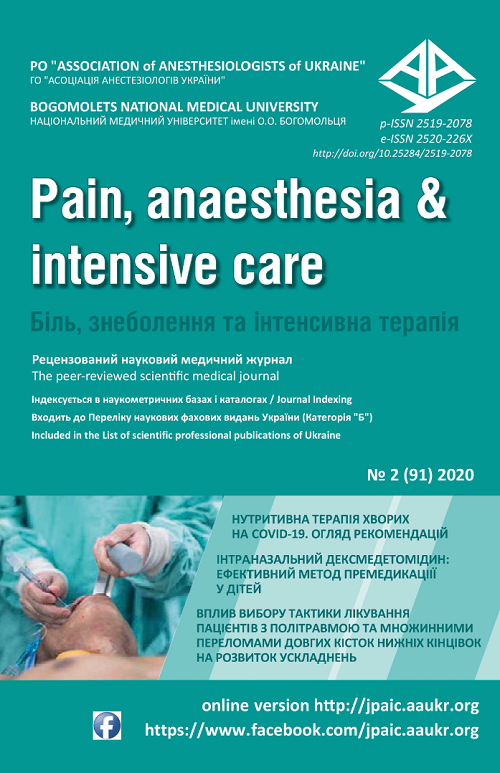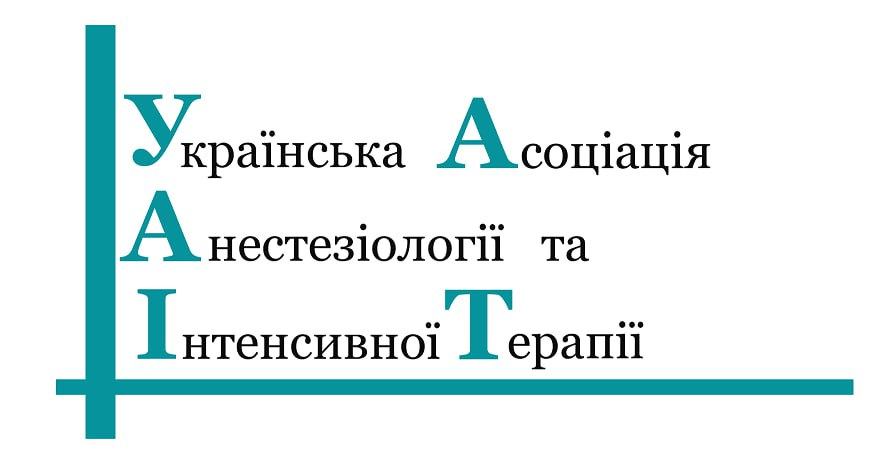ІНТРАНАЗАЛЬНИЙ ДЕКСМЕДЕТОМІДИН: ЕФЕКТИВНИЙ МЕТОД ПРЕМЕДИКАЦІІЇ У ДІТЕЙ
DOI:
https://doi.org/10.25284/2519-2078.2(91).2020.205601Ключові слова:
дексмедетомідин, інтраназальне введення, премедикація, дитяча анестезіяАнотація
Седативна премедикація є ключовим компонентом дитячої анестезії. Інтраназальний дексмедетомідин все ширше використовується при проведенні процедурних седацій та премедикації у дітей. В даній статті представлено огляд літератури та наш власний досвід стосовно використання дексмедетомідину інтраназально в якості премедикації перед хірургічними втручаннями у дітей. Дані досліджень, рекомендації провідних світових фахових організацій та наш власний досвід дозволяють стверджувати, що інтраназальне введення дексмедетомідину є ефективною та безпечною альтернативою традиційним методам премедикації у дітей.
Посилання
Kelly L., Cooper M., Wilson M. Paediatric anaesthesia: Challenges with induction /https://www.wfsahq.org/components/com_virtual_library/media/1f04daaa650700441767eec0854a348cATOTW-367-.pdf
Dave NM. Premedication and Induction of Anaesthesia in paediatric patients. Indian J Anaesth 2019;63:713-20
 |
| 
Mahmoud M, Mason KP. A forecast of relevant pediatric sedation trends.CurrOpinAnaesthesiol. 2016 Feb;29Suppl 1:S56-67. doi: 10.1097/ACO.0000000000000321.PMID: 26926335
 |
| 
Zielinska M, Bartkowska-Sniatkowska A, Becke K, et al. Safe pediatric procedural sedation and analgesia by anesthesiologists for elective procedures: A clinical practice statement from the European Society for PaediatricAnaesthesiology. PaediatrAnaesth. 2019;29(6):583–590. doi:10.1111/pan.13615
 |
| 
Weerink MAS, Struys MMRF, Hannivoort LN, Barends CRM, Absalom AR, Colin P. Clinical Pharmacokinetics and Pharmacodynamics of Dexmedetomidine. ClinPharmacokinet. 2017;56(8):893–913. doi:10.1007/s40262-017-0507-7
 |
| 
Malde AD. Dexmedetomidine as premedication in children: Status at the beginning of 2017. Indian J Anaesth. 2017;61(2):101–102. doi:10.4103/ija.IJA_61_17
 |
| 
Andropoulos DB. Effect of Anesthesia on the Developing Brain: Infant and Fetus. Fetal DiagnTher. 2018;43(1):1–11. doi: 10.1159/000475928
 |
| 
Pediatric anesthesia handbook. [ed. by Terrance A. Yemen]N. Y.: McGraw-Hill Medical Publishing Division, 2002. – 460p.
Rosenbaum A, Kain ZN, Larsson P, Lönnqvist PA, Wolf AR. The place of premedication in pediatric practice. PaediatrAnaesth. 2009;19(9):817–828. doi:10.1111/j.1460-9592.2009.03114.x
 |
| 
Hitt JM, Corcoran T, Michienzi K, Creighton P, Heard C. An evaluation of intranasal sufentanil and dexmedetomidine for pediatric dental sedation. Pharmaceutics. 2014;6(1):175–184. Published 2014 Mar 21. doi:10.3390/pharmaceutics6010175
 |
| 
Jia JE, Chen JY, Hu X, Li WX. A randomised study of intranasal dexmedetomidine and oral ketamine for premedication in children. Anaesthesia. 2013;68(9):944–949. doi:10.1111/anae.12312
 |
| 
Yuen VM, Hui TW, Irwin MG, et al. A randomised comparison of two intranasal dexmedetomidine doses for premedication in children. Anaesthesia. 2012;67(11):1210–1216. doi:10.1111/j.1365-2044.2012.07309.x
 |
| 
Yuen VM, Hui TW, Irwin MG, Yuen MK. A comparison of intranasal dexmedetomidine and oral midazolam for premedication in pediatric anesthesia: A double-blinded randomized controlled trial. Anesth Analg. 2008;106:1715–21
 |
| 
Kim HJ, Shin WJ, Park S, Ahn HS, Oh JH. The sedative effects of the intranasal administration of dexmedetomidine in children undergoing surgeries compared to other sedation methods: A systematic review and meta-analysis. J ClinAnesth. 2017;38:33– 39. doi:10.1016/j.jclinane.2017.01.014
 |
| 
Behrle N, Birisci E, Anderson J, Schroeder S, Dalabih A. Intranasal Dexmedetomidine as a Sedative for Pediatric Procedural Sedation. J PediatrPharmacolTher. 2017;22(1):4–8. doi:10.5863/1551-6776-22.1.4
 |
| 
Sathyamoorthy M, Hamilton TB, Wilson G, et al. Pre-medication before dental procedures: A randomized controlled study comparing intranasal dexmedetomidine with oral midazolam. ActaAnaesthesiol Scand. 2019;63(9):1162–1168. doi:10.1111/aas.13425
 |
| 
Peng K, Wu SR, Ji FH, Li J. Premedication with dexmedetomidine in pediatric patients: a systematic review and meta-analysis. Clinics (Sao Paulo). 2014;69(11):777–786. doi:10.6061/clinics/2014(11)12
 |
| 
Mukherjee A, Das A, Basunia SR, Chattopadhyay S, Kundu R, Bhattacharyya R. Emergence agitation prevention in paediatric ambulatory surgery: A comparison between intranasal Dexmedetomidine and Clonidine. J Res Pharm Pract. 2015;4(1):24–30. doi:10.4103/2279-042X.150051

Iirola T, Vilo S, Manner T, et al. Bioavailability of dexmedetomidine after intranasal administration. Eur J ClinPharmacol. 2011;67(8):825–831. doi:10.1007/s00228-011-1002-y
 |
| 
Miller JW, Balyan R, Dong M, et al. Does intranasal dexmedetomidine provide adequate plasma concentrations for sedation in children: a pharmacokinetic study. Br J Anaesth. 2018;120(5):1056–1065. doi:10.1016/j.bja.2018.01.035
 |
| 
Li A, Yuen VM, Goulay-Dufaÿ S, et al. Pharmacokinetic and pharmacodynamic study of intranasal and intravenous dexmedetomidine [published correction appears in Br J Anaesth. 2018 Sep;121(3):687]. Br J Anaesth. 2018;120(5):960–968. doi:10.1016/j.bja.2017.11.100
 |
| 
Li BL, Zhang N, Huang JX, et al. A comparison of intranasal dexmedetomidine for sedation in children administered either by atomiser or by drops. Anaesthesia. 2016;71(5):522–528. doi:10.1111/anae.1340
Xie Z, Shen W, Lin J, Xiao L, Liao M, Gan X. Sedation effects of intranasal dexmedetomidine delivered as sprays versus drops on pediatric response to venous cannulation. Am J Emerg Med. 2017;35(8):1126–1130. doi:10.1016/j.ajem.2017.03.021
 |
| 
Wang CY, Ihmsen H, Hu ZY, et al. Pharmacokinetics of Intranasally Administered Dexmedetomidine in Chinese Children. Front Pharmacol. 2019;10:756. Published 2019 Jul 5. doi:10.3389/fphar.2019.00756
 |
| 
Yuen VM, Hui TW, Irwin MG, Yao TJ, Wong GL, Yuen MK. Optimal timing for the administration of intranasal dexmedetomidine for premedication in children. Anaesthesia. 2010;65(9):922–929. doi:10.1111/j.1365-2044.2010.06453.x
 |
| 
Uusalo P, Guillaume S, Siren S, et al. Pharmacokinetics and Sedative Effects of Intranasal Dexmedetomidine in Ambulatory Pediatric Patients [published online ahead of print, 2019 Jun 12]. AnesthAnalg. 2019;10.1213/ANE.0000000000004264. doi:10.1213/ANE.0000000000004264
 |
| 
Malviya S, Voepel-Lewis T, Tait AR, Merkel S, Tremper K, Naughton N. Depth of sedation in children undergoing computed tomography: validity and reliability of the University of Michigan Sedation Scale (UMSS). Br J Anaesth. 2002;88(2):241–245. doi:10.1093/bja/88.2.241
 |
| 
Sidhu GK, Jindal S, Kaur G, Singh G, Gupta KK, Aggarwal S. Comparison of Intranasal Dexmedetomidine with Intranasal Clonidine as a Premedication in Surgery. Indian J Pediatr. 2016;83(11):1253–1258. doi:10.1007/s12098-016-2149-4
 |
| 
Fell D, Gough MB, Northan AA, Henderson CU. Diazepam premedication in children. Plasma levels and clinical effects. Anaesthesia. 1985;40(1):12–17. doi:10.1111/j.1365-2044.1985.tb10494.x
 |
| 
Anesthetic Pharmacology: Physiologic Principles and Clinical Practice: a companion to Miller’s Anesthesia / [ed by Evers A.S., Maze M.] Philadelphia, Churchill Livingstone, 2004. – 1092 pp
Powers AR 3rd, Gancsos MG, Finn ES, Morgan PT, Corlett PR. Ketamine-Induced Hallucinations. Psychopathology. 2015;48(6):376–385. doi:10.1159/000438675
 |
| 
Mion G, Villevieille T. Ketamine pharmacology: an update (pharmacodynamics and molecular aspects, recent fi ndings). CNS NeurosciTher. 2013;19(6):370–380. doi:10.1111/cns.12099
 |
| 
Yang F, Liu Y, Yu Q, et al. Analysis of 17 948 pediatric patients undergoing procedural sedation with a combination of intranasal dexmedetomidine and ketamine. PaediatrAnaesth. 2019;29(1):85– 91. doi:10.1111/pan.13526
 |
| 
Leroy PL, Costa LR, Emmanouil D, van Beukering A, Franck LS. Beyond the drugs: nonpharmacologic strategies to optimize procedural care in children. CurrOpinAnaesthesiol. 2016;29Suppl 1:S1–S13. doi:10.1097/ACO.0000000000000312
 |
| 
##submission.downloads##
Опубліковано
Як цитувати
Номер
Розділ
Ліцензія
Авторське право (c) 2020 Біль, знеболення та інтенсивна терапія

Ця робота ліцензується відповідно до Creative Commons Attribution-NonCommercial 4.0 International License.
Автори, які публікуються у цьому журналі, погоджуються з наступними умовами:
a. Автори залишають за собою право на авторство своєї роботи та передають журналу право першої публікації цієї роботи на умовах ліцензії Creative Commons Attribution-NonCommercial 4.0 International License, котра дозволяє іншим особам вільно розповсюджувати опубліковану роботу з обов'язковим посиланням на авторів оригінальної роботи та першу публікацію роботи у цьому журналі.
b. Автори мають право укладати самостійні додаткові угоди щодо неексклюзивного розповсюдження роботи у тому вигляді, в якому вона була опублікована цим журналом (наприклад, розміщувати роботу в електронному сховищі установи або публікувати у складі монографії), за умови збереження посилання на першу публікацію роботи у цьому журналі.
c. Політика журналу дозволяє і заохочує розміщення авторами в мережі Інтернет (наприклад, у сховищах установ або на особистих веб-сайтах) рукопису роботи, як до подання цього рукопису до редакції, так і під час його редакційного опрацювання, оскільки це сприяє виникненню продуктивної наукової дискусії та позитивно позначається на оперативності та динаміці цитування опублікованої роботи (див. The Effect of Open Access).








